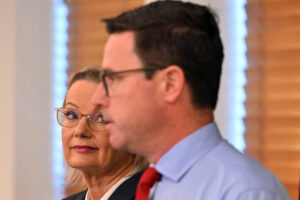by Ebony Bennett
[Originally published in the Canberra Times, 03 October 2020]
Pioneering feminist Susan Ryan sadly passed away this week, not long after United States Supreme Court Justice Ruth Bader Ginsburg. While Ruth Bader Ginsburg pursued American women’s equality and freedom through the courts, Susan Ryan pursued it through the parliament, running on a platform that “a woman’s place is in the Senate”.
Ryan was the first ever woman cabinet minister in a Labor government during Bob Hawke’s prime ministership, and for many years the only one. Following her death, it is the 1984 Sex Discrimination Act that shines as the crowning achievement of her legacy of service.
Before the Sex Discrimination Act, sexual harassment in the workplace was perfectly legal. Men could grope, leer, make lewd jokes and repeatedly come on to their female colleagues, and women just had put up with it. It was also legal to discriminate against women in employment due to their marital status or pregnancy (it wasn’t that long since the public service had abandoned its policy of firing women once they got married).
Of course, just because something is unlawful doesn’t mean it’s not still common. Many of the complaints resolved each year by the Australian Human Rights Commission are to help women who have been sexually harassed while doing their job, or who have been fired or demoted for disclosing a pregnancy, for example – but the act gives women the ability to appeal to an independent umpire and most complaints are resolved by mediation rather than going to court. A prominent commentator this week criticised anti-discrimination commissions as having “tyranny built into their design” – a curious accusation from a straight, white male who has never had to fear for his job or promotion when disclosing a pregnancy to his boss, as many women have. It’s easy to dismiss the importance of that which doesn’t affect you personally, but it’s within living memory that banks wouldn’t even give mortgages to single or divorced women. The Sex Discrimination Act that Susan Ryan shepherded through Parliament in the ’80s, decades later, offers women some protection from the tyranny of being lawfully groped at work or being fired for complaining about it.
The increase of women’s participation in the workforce, enabled by the Sex Discrimination Act and similar legislation, is one of the most significant labour market trends of the past few decades. As more women joined the workforce, Australia’s GDP grew. What’s good for women is good for the Australian economy too.
The COVID-19 restrictions were designed to prevent a public health emergency, not to erode women’s participation in the workforce.
Women like Susan Ryan pioneered a path to equality for Australian women – but that is now at risk. No, we’re not going to suddenly legalise sexual harassment, but women are bearing the brunt of this recession in ways that could reverse all the gains we have fought so hard for.
Research from the Australia Institute’s Centre for Future Work shows that women’s employment declined by 210,000 positions, or 3.4 percent, from February through August, compared with a decline of 2.9 per cent for men. Only 60 per cent of women are in the workforce, 115,000 less since February; a decline of 1.3 percentage points compared with a 1.1 percentage-point decline for men. What’s worse is that the majority of women’s jobs lost since February have been full-time, some 120,000 positions – but 88 per cent of women’s jobs growth since May has been part-time – meaning when women do get back into the labour market, they’re likely to be constrained to insecure and part-time positions.
As my colleague, senior economist Alison Pennington, has pointed out, women have been subject to a perfect storm of problems: greater exposure to customer-facing industries that were first to shut and will likely be slowest to recover like hospitality and retail, a higher likelihood to work in insecure or part-time positions that make women cheaper to sack, and lastly an “explosion in the caring burden, pushing women to sacrifice paid work to care for their families”.
The COVID-19 restrictions were designed to prevent a public health emergency, not to erode women’s participation in the workforce. Nevertheless, that has been the outcome. The federal government has so far done bugger all to target stimulus towards women in its economic response. There were great hopes when the government instituted free childcare – removing one of the biggest barriers to women’s workforce participation – but that was soon scrapped. Federal government announcements have instead been targeted at jobs for the boys in construction, gas and manufacturing, because they provide the kind of hard-hat and high-vis photo ops the male-dominated cabinet enjoys (just 6 of 23 ministers in Scott Morrison’s cabinet are women).
It’s worse than that though. If the Morrison government brings forward stages 2 and 3 of its income tax cuts package, it will be among the most egregious economic mistakes this government has made. Analysis by the Australia Institute shows that, in total, men will get 70 per cent of the benefit of the tax cuts, and women will get just 30 per cent of the tax cut. That is, if the tax cuts were worth $1 million dollars, men would receive $700,000 and women just $300,000. Except we’re talking billions, not millions.
The income tax cuts are also targeted at high-income earners, who are disproportionately male. The bottom half of income earners will receive just 3 to 4 per cent of the benefit of the tax cuts, while the top 20 per cent of income earners will receive around 90 per cent of the benefit. So, if the tax cuts were worth $1 million dollars and all income earners were represented as 10 people lined up from lowest to highest income, the two highest-income earners would receive $900,000 and the bottom five would receive just $30,000.
What’s more, we know those bottom five people will spend all their money. But the top two highest-income earners are more likely to save that $900,000. The aim is to stimulate spending, so there is no point giving a handout to those who will save it. It makes no economic sense to waste money on income tax cuts for people who don’t need financial help, and it’s cruel to do it at the same time as plunging hundreds of thousands of Australians into poverty by cutting the Jobseeker supplement.
Susan Ryan and Ruth Bader Ginsburg leave a legacy that liberated generations of women. The upcoming federal budget will decide if the Morrison government’s legacy is to set Australian working women back for generations to come.
Ebony Bennett is deputy director at independent think tank The Australia Institute. Twitter: @ebony_bennett.
Between the Lines Newsletter
The biggest stories and the best analysis from the team at the Australia Institute, delivered to your inbox every fortnight.
You might also like
Gender parity closer after federal election but “sufficiently assertive” Liberal women are still outnumbered two to one
Now that the dust has settled on the 2025 federal election, what does it mean for the representation of women in Australian parliaments? In short, there has been a significant improvement at the national level. When we last wrote on this topic, the Australian Senate was majority female but only 40% of House of Representatives
Australia’s parliaments closing in on gender parity, in spite of coalition “women problem” – new analysis
New analysis by The Australia Institute reveals that, following the recent federal election, there are now more women than ever in Australia’s nine parliaments, but the coalition’s so-called “women problem” remains.
Coalition offers crash course on staying in opposition for forever
If the Coalition’s aim is to stay in opposition, it’s doing a bang-up job.


